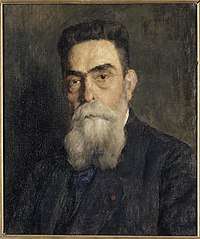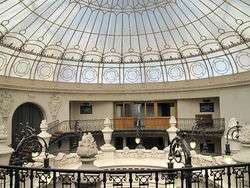Victor Laloux
Victor Alexandre Frederic Laloux (15 November 1850 – 13 July 1937) was a French Beaux-Arts architect and teacher.

Life
Born in Tours, Laloux studied at the Paris École des Beaux-Arts atelier of Louis-Jules André, with his studies interrupted by the Franco-Prussian War, and was awarded the annual Prix de Rome in 1878. He spent 1879 through 1882 at the Villa Medici in Rome.
On his return to France Laloux rose quickly through the academic system, serving on many juries, societies and foundations. As practitioner, he produced major commissions in a highly ornamented neo-classical surface style, collaborating with sculptors and muralists squarely in the Beaux-Arts tradition, but doing so on innovative cast-iron frames. Metal framing allowed higher interior spaces, more generous fenestration, and glass roofs, notably in the sunlit barrel-vault of the Gare d'Orsay.
Laloux was awarded the American AIA Gold Medal in 1922, and the RIBA Royal Gold Medal in 1929. In 1932 he was elected into the National Academy of Design as an Honorary Corresponding Academician. In 1936, the year before his death, his successor as head of the atelier was Charles Lemaresquier. He died in Paris, aged 86.
Work
Laloux's work includes:
- the neo-Byzantine Basilica of St. Martin, Tours, in Tours, 1886–1924 – a project with some political connotations as it was built to replace an earlier Basilica destroyed during the French Revolution.
- Gare de Tours, in Tours, 1896–1898, with four allegorical limestone statues of cities by Jean Antoine Injalbert (Bordeaux and Toulouse) and Jean-Baptiste Hugues (Limoges and Nantes)
- the Paris Gare d'Orsay, now the Musée d'Orsay, 1900
- Hotel de Ville, Roubaix, 1903, with architectural sculpture by Alphonse-Amédée Cordonnier
- Hotel de Ville, Tours, 1904, also with sculpture by Cordonnier
- completion of the Crédit Lyonnais headquarters, Paris, 1913
- the U.S. Embassy, Paris, with his student, American architect William Delano, 1931
- Palais du Hanovre, Paris, with his student Charles Lemaresquier, 1932[1]
Influence

As professor, Laloux assumed the direction of Louis-Jules André's atelier when André died in 1890. Laloux would ultimately train about 600 students through the years, including 132 Americans.[2] Laloux's influence is visible in the U.S. in buildings like the 1921 San Francisco City Hall. Atelier training in the context of the École focused on the annual Prix de Rome competition, and by this measure Laloux was the school's most successful teacher, training 16 winners.[3]
The students educated in Laloux's atelier include:
- William Lawrence Bottomley, American[4]
- Arthur Brown, Jr., American
- Jacques Carlu, French
- George Shepard Chappell, American[5]
- François-Benjamin Chaussemiche, French
- John Walter Cross of Cross and Cross, American[6]
- Jacques Debat-Ponsan, French
- William Delano, American
- Georges Gromort,[7] French
- Henry Gutton, French
- George Howe, American
- Gustave Louis Jaulmes, French
- Charles Lemaresquier, French
- José Marques da Silva, Portuguese
- Miguel Ventura Terra, Portuguese
- Robert Touzin (fr), French
- Guillaume Tronchet, French
- William Van Alen, American, designer of the Chrysler Building
- Charles Weeks of Weeks and Day, American
- Lucien Weissenburger, French
- Duiliu Marcu , Romanian
External links
- Works by or about Victor Laloux in libraries (WorldCat catalog)
- online biography
References
- Palais de Hanovre @ Structurae.
- Long Island country houses and their architects, 1860–1940 By Robert B. MacKay, Anthony K. Baker, Carol A. Traynor, page 128
- Long Island country houses and their architects, 1860–1940 By Robert B. MacKay, Anthony K. Baker, Carol A. Traynor, page 128
- The architecture of Delano & Aldrich By Peter Pennoyer, Anne Walker, page 13
- The architecture of Delano & Aldrich By Peter Pennoyer, Anne Walker, page 13
- The architecture of Delano & Aldrich By Peter Pennoyer, Anne Walker, page 13
- The elements of classical architecture By Georges Gromort, page 11
| Wikimedia Commons has media related to Victor Laloux. |